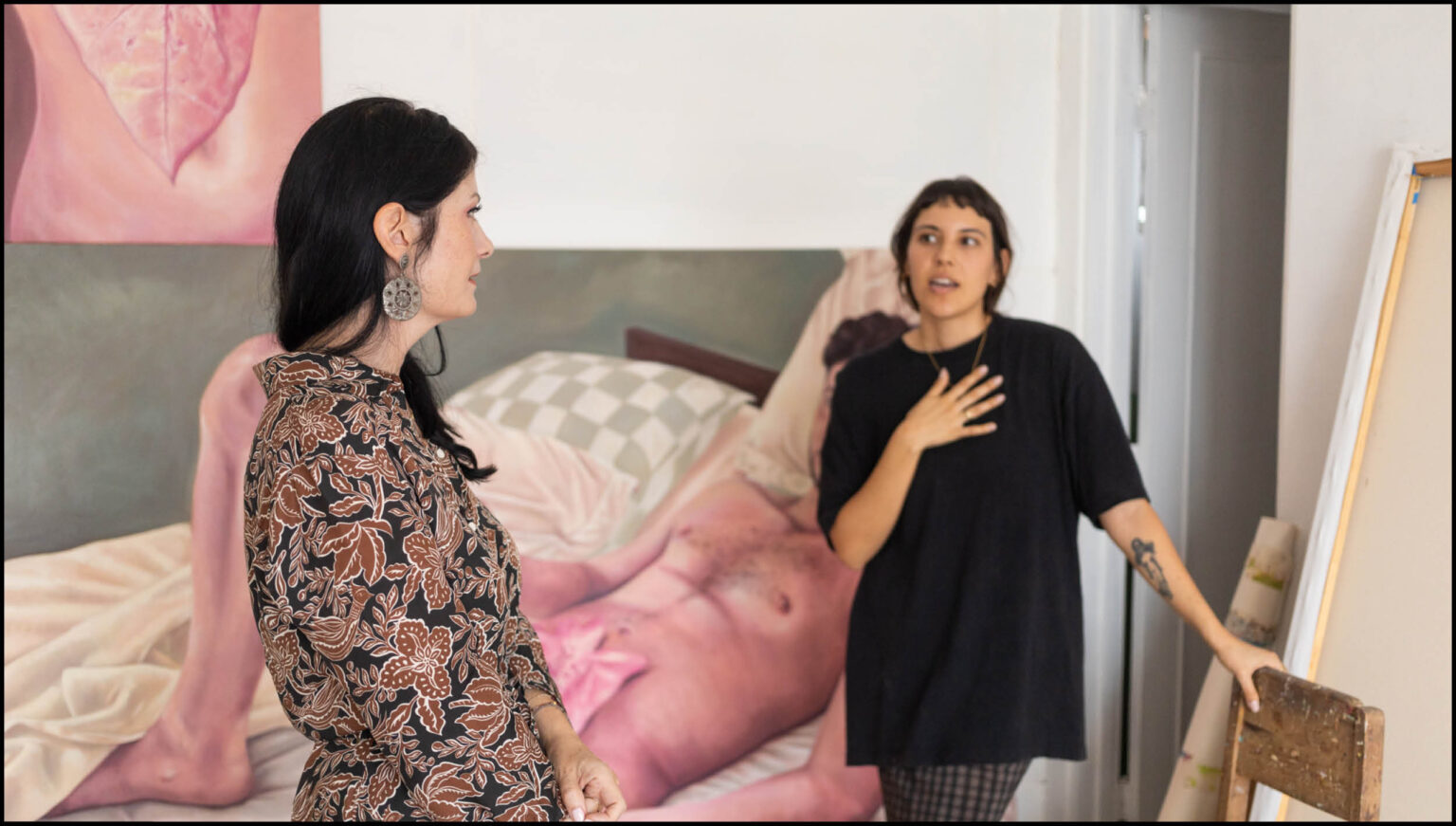
In conversation with curator
and satis.FACTORY "amigue" Hannah Sloan
A brief Q&A between curator and satis.FACTORY director Erika Martin and Hannah Sloan
EM: You have been visiting Costa Rica for a couple of years, researching the local scene and seeking out artists. What have you discovered or found most interesting thus far?
HS: In general, I have found an exceptionally high level of artistic excellence coming from contemporary artists working in Costa Rica and much like Los Angeles, I see alternative, artist-run spaces as crucial to the developments in art that are happening right now. Despite a limited array of opportunities for artists within Costa Rica, there is abundance of experimentation within the arts and some of the most powerful work I’ve seen is the least commercially viable. I’ve also been impressed by the awareness of international art trends that many of your artists possess, while they are producing work that is highly individual, and specific to their identity as Costa Ricans. For the most part, there is a camaraderie within the art community and an eagerness to share ideas and support each other that I find refreshing and it makes me optimistic about the direction of the art scene. Most importantly, I have found a very receptive and cooperative community of artists, collectors, and curators who have become instrumental in my ability to connect to the local art scene in a meaningful way. Having access to a growing network of allies is vital to my ability to discover and introduce talented Costa Rican artists to the art market in the United States. Art collectors Esteban Guardia and Pamela Corrales, curators like Susana Sánchez Carballo and yourself, and the folks at Cero Uno, Abra Espacio, satis_FACTORY and Salita_Temporal have all been incredibly supportive of my endeavors, not just in terms of introducing me to artists but also by providing space for me to work, helping me with logistics and giving me valuable advice. The eagerness to collaborate throughout this entire process is incredible. For an outsider, the Costa Rican art scene can seem relatively small, but once a few doors opened for me I quickly realized there is an expansive pool of talent out there and it seems to be growing every day.
EM: Could you please tell us more about Sloan Projects: how and why did it come to life? What is its mission or what are its primary goals?
HS: I began my career in 2004 as the Director of a prominent gallery of modern and contemporary art in Los Angeles, where I represented and worked closely with legends of the photography world like Graciela Iturbide, William Eggleston, Todd Hido, Martin Parr, and Rinko Kawauchi, to name just a few. It was an exceptional time to be in the art world, but after a decade in that role, my interests shifted and I wanted to explore new ideas. I founded Sloan Projects in 2015 as a place to exhibit work by emerging and mid-career multidisciplinary artists with an emphasis on women artists from the Los Angeles area. At that time, men were far more likely than women to land solo exhibitions in galleries so I established a space that offered solo exhibitions exclusively to women, as a way of countering a longstanding cultural-historical injustice. Since that time, my program has expanded to include artists of different backgrounds, but my primary goal has stayed the same – to provide a platform for underrepresented artists to showcase conceptually challenging and technically masterful work. I also put a lot of effort into placing work by women and Latinx artists into major museum collections in the United States, because this is a crucial step toward correcting imbalances in representation on an institutional level, and it’s also an exciting thing to do. This summer I am celebrating twenty years in the art business as a gallerist, a curator, and as an advisor to major collections of art and have recently rebranded my company as Hannah Sloan Curatorial & Advisory because my focus has always been curating shows, advising artists, and helping collectors and museums acquire contemporary art.
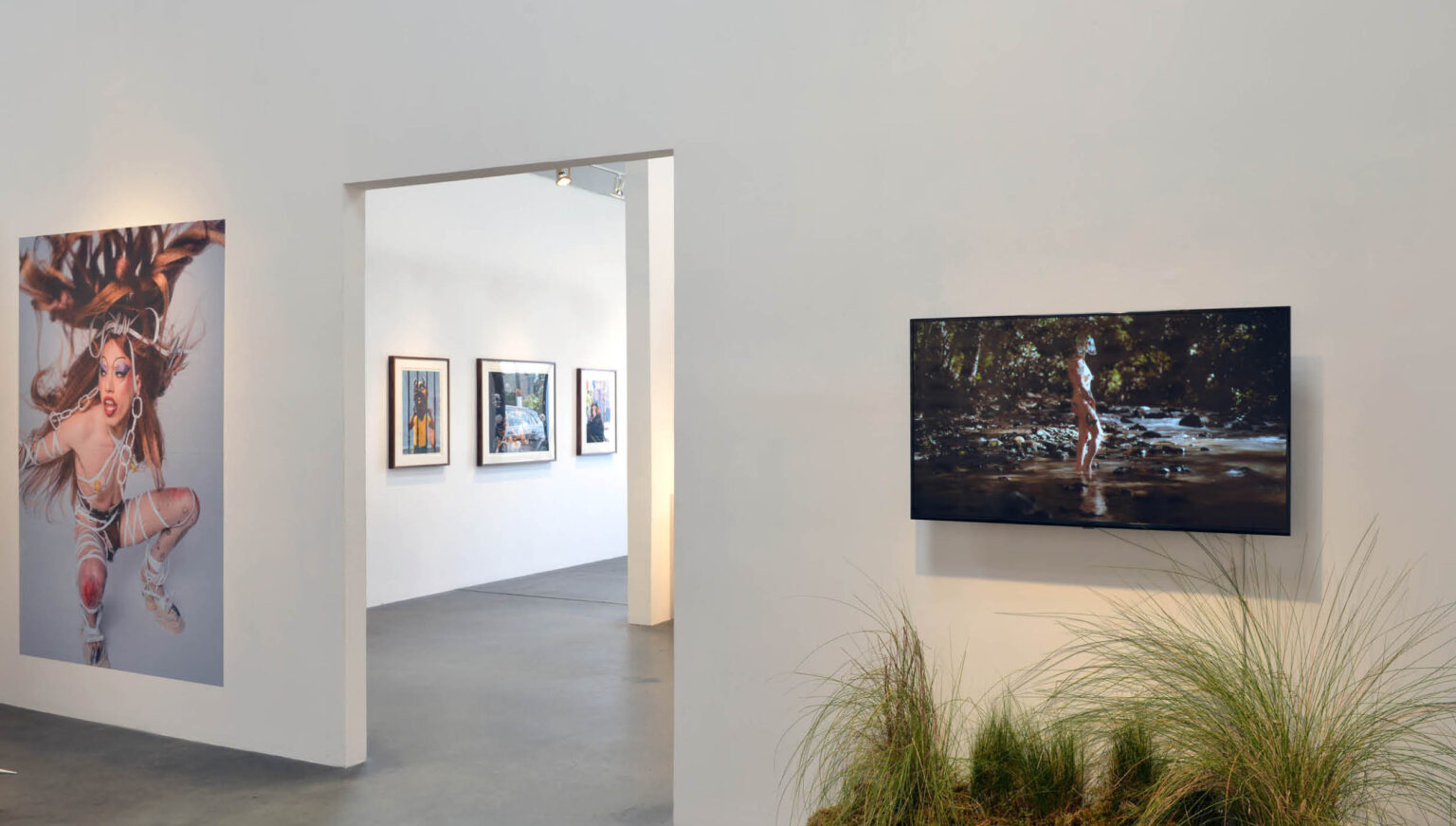
Partial View, Seguimos: Contemporary Art in Costa Rica. Curated by Sloan Projects at Craig Krull Gallery, Los Angeles.
In this photo works by La Cholla Jackson, Lucía Howell and Adrian Arguedas.
EM: A few weeks ago you closed Seguimos: Contemporary Art in Costa Rica, a show organized by Sloan Projects featuring 13 Costa Rica artists from different backgrounds, who explore different mediums such as painting, photography installation, video art, printmaking, and sculpture. I found your selection interesting, particularly the intergenerational quality it had, which we rarely see in local shows in San José (Costa Rica). How did you find this mix came together and how perceive that the L.A. scene received this selection of works?
HS: When I initially decided to curate an exhibition of Costa Rican art in Los Angeles there were many different directions I could have taken in terms of which artists to present and what genre of art to feature. In fact, at one point, I was planning a show of abstract work by women artists because I believe that we are going to see a renewed interest in abstraction throughout the art market in the next few years. But after a lot of research and input from gallery owner Craig Krull, who hosted my exhibition, I started to focus on some of the tough, conceptual work we had been seeing, by artists like Priscilla Romero Cubero, Javier Calvo and La Cholla Jackson. We ultimately selected a group of artists whose strong perspectives would tell a compelling story about what artists are thinking about and living through in Costa Rica today. Even before the show opened I knew this was the right decision because of the buzz we began receiving. As you may know, the competition for attention in the fast-growing L.A. art world is extreme, so the high level of response we received from art collectors, museum curators, the general public, and the press was encouraging.
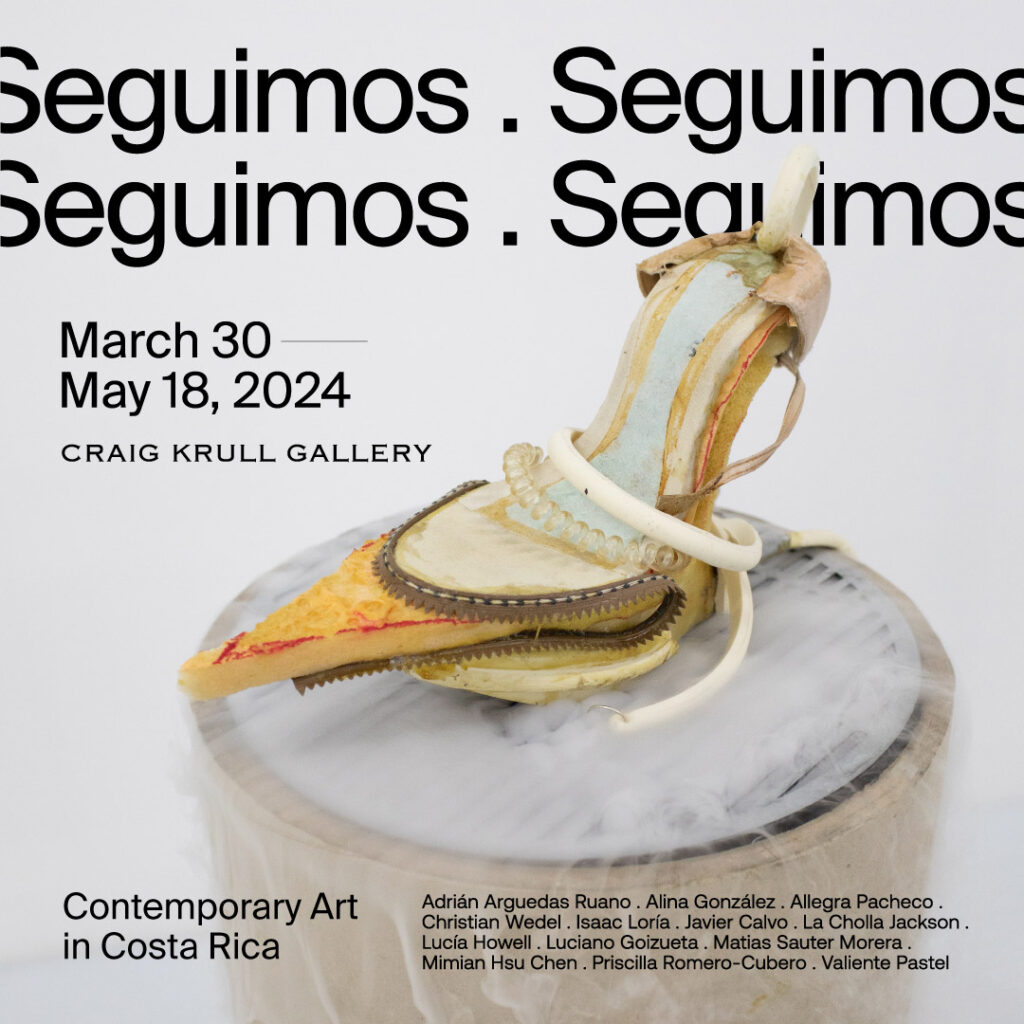
I had two intentions while curating Seguimos.
One was to share my passion and interest in Costa Rican contemporary art by educating the public, and the other was to support Costa Rican artists by allowing them to establish themselves in the United States through exposure and sales. We accomplished both of these goals, and several artists from our show are going on to exhibit in prominent museums around the U.S. later this year and the next. By debuting a really broad group of artists under the umbrella of “contemporary art in Costa Rica,” we set the stage for successful solo exhibitions with a tighter focus in the future.
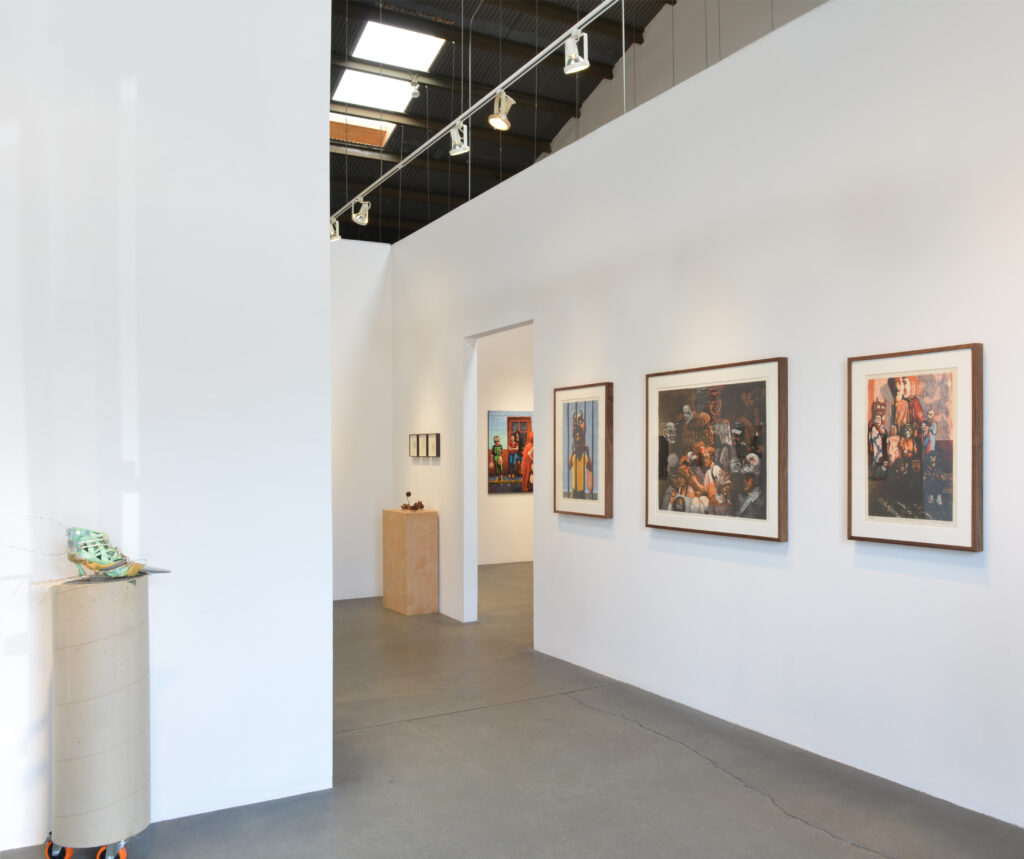
Partial View, Craig Krull Gallery I Seguimos, 2024 I In this photo La Cholla Jackson and Adrian Arguedas.
Artists Matias Sauter Morera and Katrin Aason Bucher both have solo exhibitions scheduled for 2025 in Los Angeles, and others are likely to follow. I also learned that even in an environment like Los Angeles, where we have a highly educated art community, there is a shocking naivety about Costa Rica and what kind of art is produced there. Many visitors to our show came with embarrassing biases about what Central American art looks like and were expecting to see traditional crafts. I think some people were completely surprised by what they saw and hopefully, it opened their minds to the nuances of Costa Rican contemporary art. I also noticed that people in L.A. are particularly receptive to queer artists and there was an immediate appreciation for the courageous work that artists Alina González, Valiente Pastel, and Matias Sauter Morera are doing around queer subject matter.
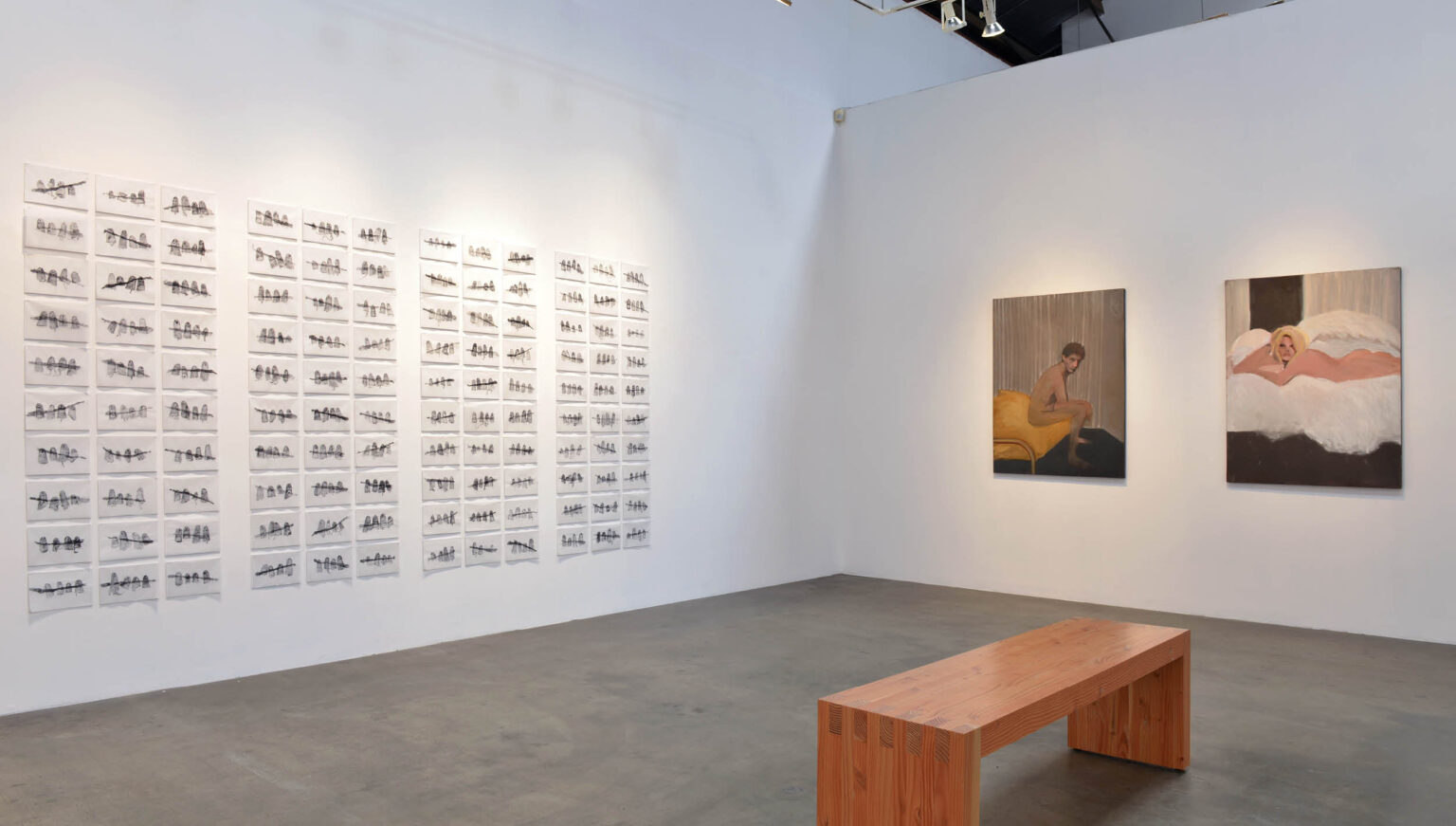
Partial View, Craig Krull Gallery I Seguimos, 2024 I In this photo Priscilla Romero and Alina Gónzalez.
EM: As you know, we currently do not have any contemporary art galleries in San José, and our collector spectrum is limited, which is why a show like Seguimos is so urgent. This exhibition allowed Costa Rican art to cross borders, and enter a more profitable market. Do you think there is a genuine interest and potential market for Costa Rican or Central American art within the United States?
HS: When we talk about contemporary art galleries, I don’t want to overlook the importance of artist-run spaces in San José such as Cero Uno or salita_Temporal, or small commercial galleries like DeCerca Gallery, which are supporting artists in valuable ways. But to answer your question – Yes. On an institutional level around the U.S., there is a rapidly growing interest in contemporary art from Central and South America, and that alone is creating a market for work coming out of these areas. During my exhibition, Seguimos, I learned that the J. Paul Getty Museum is in the process of hiring a dedicated curator of Latin American art for its photography department. A curator from the Santa Barbara Museum of Art visited our show because they were looking for work specifically by Latin American women artists for an exhibition this coming Fall. Other institutions in the United States are doing the same every single day, so I think it is safe to say that we are in an era of unprecedented possibility for contemporary Latinx artists. American collectors still need to be educated about confidently buying art from Costa Rica and other Central American countries, and that is a process that takes time, but I feel that we are moving in a healthy direction where more Central American artists will be able to find success here in the U.S. and globally.
EM: How would you suggest that local artists or independent spaces can tap into this market? How could we go about building ties with both cultural makers and institutions in the U.S. that could in turn strengthen our local contemporary arts community that counts on little to no local funding?
HS: Cultural exchange is critical for anyone wanting to tap into the art market abroad. When I visit most art venues in Costa Rica I notice a general lack of exhibiting artists from outside the country. On the one hand, I completely understand that given a limited number of opportunities for artists in the country, that the focus should be on regional artists whenever possible. But at the same time, inviting artists from outside of Central America into the fold is essential to building connections and expanding resources abroad. Now is the time to take advantage of the explosion of interest in Latinx art worldwide.
Encouraging a flow of people and artistic ideas in and out of Costa Rica is going to be a key factor in expanding your opportunities for artists. Institutions as well as artist-run spaces need to open their doors more frequently to international curators and artists. I also encourage local artists to pay close attention to what is happening in metropolitan art centers like L.A., New York, and CDMX through social media and be prepared to take advantage of opportunities when they arise. Through Instagram, several artists who were involved in Seguimos were aware of a prominent Arist-in-Residence program for international artists here in L.A. that is run by Danny First. Because they had done their homework and asked me about this opportunity, I was able to introduce them and make connections on their behalf when they visited L.A.
There are thousands of Artist-Residency programs in the U.S. and many of them offer scholarships. I highly recommend seeking out these opportunities whenever possible. If in-person exchanges aren’t feasible, focus on building connections virtually. I recently hosted an Instagram Live exchange with Costa Rican artist Isaac Loría, where he gave me a tour of the art studio where he works. The response from viewers in Los Angeles was so positive that we are developing a series of Instagram Live events where I will introduce artists and culture-makers from Costa Rica to my L.A. audience. Use free and accessible social media tools wherever possible to create connections and opportunities for more visibility, not only for your artists but for your curators and educators as well. And lastly, keep a dialogue going with people like myself who have a specific interest in your artists. The more I know and am aware of, the better prepared I will be to make connections on your behalf.
Entrevista en español
Con el interés de compartir sobre la alianza entre Hannah Sloan Curatorial & Advisory y satis.FACTORY para contextualizar sus vínculos, Erika Martin (directora de satis.FACTORY) entrevistó brevemente a la curadora y asesora Hannah Sloan sobre su plataforma, percepciones e intereses en el arte costarricense. A su vez, se comenta sobre su proyecto expositivo más reciente Seguimos: arte contemporáneo en Costa Rica, presentado en Los Ángeles del 30 de marzo al 18 de mayo.
EM: Nos conocimos el año pasado por medio de un intercambio profesional ante su interés por ampliar su conocimiento de artistas contemporáneos costarricenses. En ese momento curé una pequeña gira de visitas de estudio que incluyó artistas emergentes, de mediana carrera y un par ya legitimados, como en el caso de Adrián Arguedas.
Desde el primer contacto, hasta el día de hoy, agradezco mucho el voto de confianza sobre mi criterio y conocimiento del arte contemporáneo local. En ese momento comprendí que llevaba un par de años familarizándose con Costa Rica e investigando el ecosistema de las artes visuales y conociendo personalmente a los artistas. Esto me lleva a preguntar preguntar: ¿qué ha descubierto o ha sobresalido de una escena tan pequeña en comparación a una ciudad como Los Ángeles?
HS: En general, he encontrado un nivel excepcional artístico entre los artistas contemporáneos que trabajan en Costa Rica y, al igual que en Los Ángeles, considero que los espacios alternativos gestionados por artistas son cruciales para el desarrollo del arte que se está produciendo. A pesar de la escasez de oportunidades para los artistas en Costa Rica, la experimentación artística es abundante y algunas de las obras más impactantes que he visto son las menos viables comercialmente. También me ha impresionado su conocimiento de las tendencias artísticas internacionales, a la vez que producen obras específicas a su contexto e identidad como costarricenses. En general, existe una camaradería dentro de la comunidad artística y un afán por compartir ideas y apoyarse mutuamente que me parece refrescante y me hace ser optimista sobre la dirección de la escena artística. Aún más importante, he encontrado una comunidad de artistas, coleccionistas y curadores muy receptiva y colaboradora, la cual ha sido fundamental para lograr conectar con la escena local de forma significativa.
Tener acceso a una creciente red de aliados es vital para mí capacidad de descubrir e introducir artistas costarricenses al mercado del arte en Estados Unidos. Los coleccionistas de arte Esteban Guardia y Pamela Corrales, curadoras como Susana Sánchez Carballo y vos misma, al igual que la gente de Cero Uno, Abra Espacio, satis.FACTORY y la Salita_Temporal me han apoyado increíblemente, no sólo presentándome artistas sino también proporcionándome espacio para trabajar, ayudándome con logística y dándome valiosos consejos. El afán de colaboración a lo largo de todo este proceso ha sido increíble. Para alguien externo, la escena artística costarricense puede parecer pequeña, no obstante, una vez que se abrieron algunas puertas me di cuenta que hay una gran cantidad de talento que parece crecer día a día.
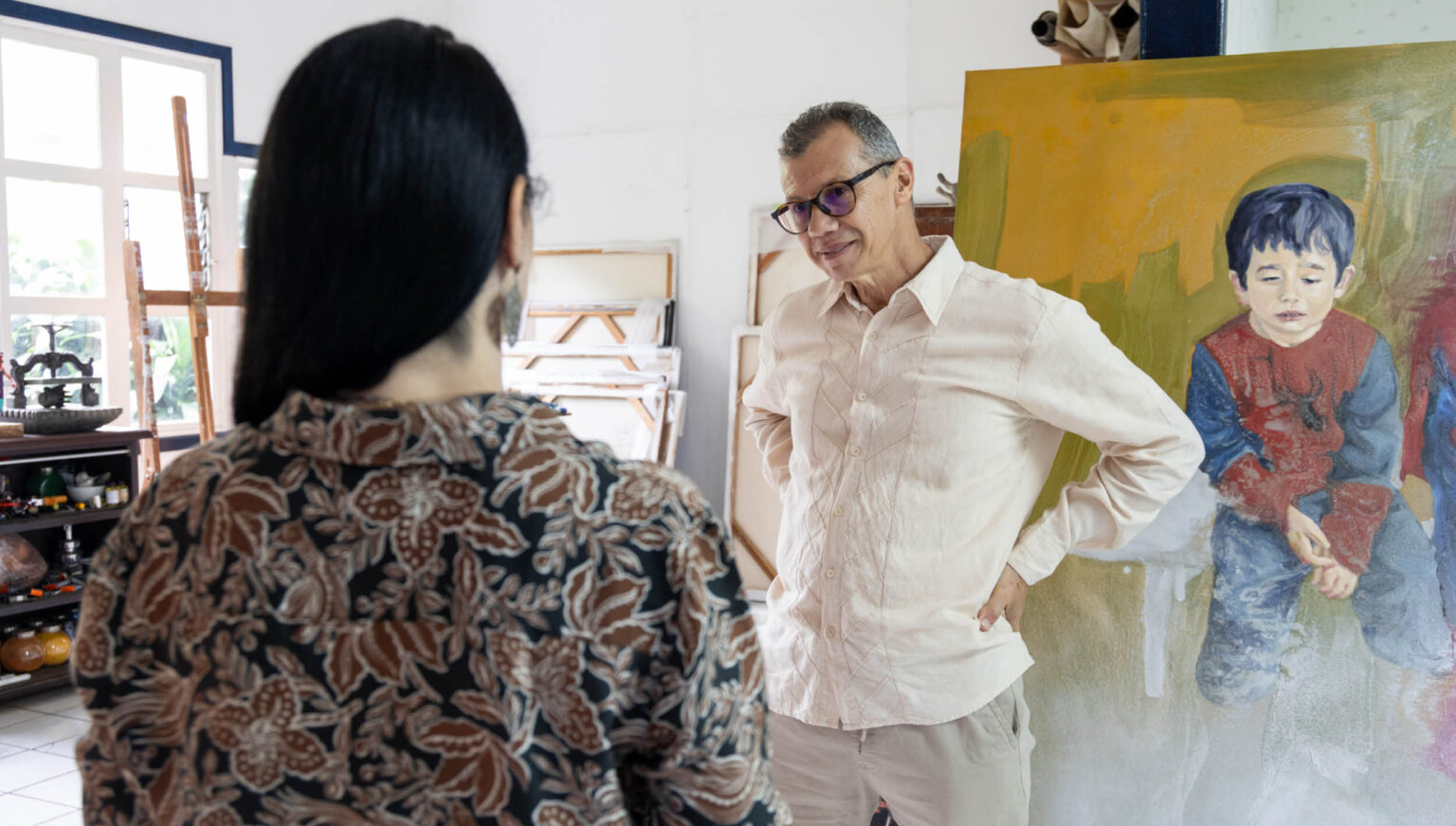
Hannah Sloan visiting Adrian Arguedas’s studio in Barva de Heredia, Costa Rica.
EM: Hablemos un poco más de Sloan Projects: ¿cómo y para qué surge? ¿Cuál es su misión y cuáles son sus objetivos principales?
HS: Comencé mi carrera en el 2004 como directora de una destacada galería de arte moderno y contemporáneo de Los Ángeles, donde representé y trabajé de manera cercana con íconos del mundo de la fotografía como Graciela Iturbide, William Eggleston, Todd Hido, Martin Parr y Rinko Kawauchi, por nombrar sólo algunos. Fue una época excepcional para estar en el mundo del arte, pero tras una década en ese puesto, mis intereses cambiaron y quise explorar nuevas ideas.
Fundé Sloan Projects en 2015 para exponer obras de artistas multidisciplinares emergentes y a mitad de carrera, con especial atención en mujeres artistas de la zona de Los Ángeles. En ese momento, los hombres tenían más probabilidades que las mujeres de conseguir exposiciones individuales en galerías, así que creé un espacio que ofrecía exposiciones individuales exclusivamente a mujeres, como una forma de contrarrestar una injusticia histórico-cultural. Desde entonces, mi programa se ha ampliado para incluir a artistas de distintas procedencias, aunque mi objetivo principal ha seguido siendo el mismo: ofrecer una plataforma para que artistas poco representados o visibilizados muestren obras conceptualmente desafiantes y técnicamente ejemplares. También pongo mucho empeño en colocar obras de mujeres y artistas latinos en las colecciones de los principales museos de Estados Unidos, ya que no sólo es algo que me resultado emocionante, y a la vez un paso crucial para corregir los desequilibrios en la representación a nivel institucional.
Este verano celebro veinte años en el mundo del arte como galerista, curadura y asesora de importantes colecciones de arte, y recientemente he rebautizado mi empresa como Hannah Sloan Curatorial & Advisory, porque siempre me he centrado en curar exposiciones, asesorar a artistas y ayudar a que coleccionistas y museos adquieran arte contemporáneo.
EM: En mayo de este año clausuró Seguimos: Arte Contemporáneo en Costa Rica, una muestra organizada por Sloan Projects en la que participaron 13 artistas costarricenses quienes exploran distintos medios como la pintura, la instalación fotográfica, el videoarte, el grabado y la escultura. Esta selección me pareció interesante, sobre todo por su carácter intergeneracional, que rara vez vemos en las exposiciones locales en San José (Costa Rica). ¿Cómo fue el proceso de selección y cómo percibió que la escena de Los Ángeles recibiera la exposición?
HS: Cuando decidí curar una exposición de arte costarricense en Los Ángeles, pude haber tomado muchas decisiones sobre cuáles artistas presentar y qué género. De hecho, en un momento dado, estaba planeando una exposición de obras abstractas de mujeres artistas porque creo que en los próximos años veremos un renovado interés por la abstracción en el mercado del arte. Sin embargo, tras dos años investigando, sumada la asistencia del galerista Craig Krull, quien acogió mi exposición, empecé a centrarme en las obras profundas y conceptuales que habíamos estado viendo, tales como Priscilla Romero Cubero, Javier Calvo y La Cholla Jackson. De manera que seleccionamos un grupo de artistas cuyas fuertes perspectivas contarían una historia convincente sobre lo que los artistas están pensando y viviendo hoy, en Costa Rica. Antes de inaugurar la exposición, supe que había sido una decisión acertada por la atención que empezamos a recibir. Como ya sabrán, la competencia por sobresalir en el creciente mundo del arte de Los Ángeles es extrema, por lo que la gran respuesta que recibimos de coleccionistas, curadores de museos, el público en general y la prensa fue alentadora.
Tenía dos intenciones al curar Seguimos.
Una era compartir mi pasión e interés por el arte contemporáneo costarricense educando al público. La otra era apoyar e introducir a algunos de los artistas costarricenses al mercado estadounidense a través de la exposición y las ventas. Hemos logrado ambos objetivos, y varios artistas de la exposición van a exponer en destacados museos de Estados Unidos a finales de este año y el siguiente. Al presentar por primera vez a un grupo muy amplio de artistas bajo el lema “arte contemporáneo en Costa Rica”, sentamos las bases para futuras exposiciones individuales de mayor éxito.
Los artistas Matías Sauter Morera y Katrin Aason Bucher tienen exposiciones individuales programadas para el 2025 en Los Ángeles, y es probable que les sigan otras. También aprendí que incluso en un entorno como el de Los Ángeles, donde contamos con una comunidad artística educada, existe un gran desconocimiento sobre Costa Rica y el tipo de arte que se produce allí. Muchos visitantes de nuestra exposición venían con prejuicios sobre cómo es el arte centroamericano y esperaban ver artesanía tradicional. Creo que a algunos les sorprendió completamente lo que vieron y espero que les haya abierto la mente a los matices del arte contemporáneo costarricense. También me di cuenta de que el público en Los Ángeles es particularmente receptivo a los artistas queer y hubo un aprecio inmediato por el valiente trabajo que Alina González, Valiente Pastel y Matias Sauter Morera están creando en torno a la temática e identidades de la comunidad LGTBQ+.
EM: Como estarás al tanto, actualmente hay muy pocas galerías de arte contemporáneo en San José, y nuestro espectro de coleccionistas es limitado, por eso resulta tan urgente una muestra como Seguimos. Esta exposición permitió que el arte costarricense traspasara fronteras, y se vinculara con un mercado más lucrativo. ¿Cree que existe un interés genuino y un potencial de mercado para el arte costarricense o centroamericano en los Estados Unidos?
HS: Cuando hablamos de galerías de arte contemporáneo, no quiero pasar por alto la importancia de los espacios gestionados por artistas en San José, como Cero Uno o salita_Temporal, o pequeñas galerías comerciales como DeCerca Galería, que sin duda hacen un esfuerzo y trabajo valioso.
No obstante, para responder a tu pregunta, sí. A nivel institucional, en Estados Unidos está creciendo rápidamente el interés por el arte contemporáneo Latinoamericano, lo que está creando un mercado para las obras procedentes de estas zonas. Durante mi exposición Seguimos, me enteré de que el Museo J. Paul Getty está a punto de contratar a un curador especializado en arte latinoamericano para su departamento de fotografía. Un curador del Museo de Arte de Santa Bárbara visitó nuestra exposición porque buscaban obras de mujeres latinoamericanas para una muestra que se celebrará el próximo otoño. Otras instituciones de Estados Unidos hacen lo mismo cada día, así que creo que podemos afirmar que estamos en una época de posibilidades sin precedentes para los artistas latinoamericanos contemporáneos. Los coleccionistas estadounidenses aún deben aprender a comprar con confianza obras de Costa Rica y otros países centroamericanos, y ese es un proceso que lleva tiempo, pero creo que estamos avanzando en una dirección saludable en la que más artistas centroamericanos podrán tener éxito, aquí en Estados Unidos, y en el resto del mundo.
EM: ¿Cómo sugeriría que los artistas locales o los espacios independientes pueden aprovechar este mercado? ¿Cómo podríamos establecer vínculos con creadores culturales e instituciones de Estados Unidos que, a su vez, reforzarán la comunidad artística contemporánea local, la cual cuenta con poca financiación?
HS: El intercambio cultural es absolutamente fundamental para cualquiera que quiera introducirse en el mercado del arte en el extranjero. Cuando visito la mayoría de las salas de arte de Costa Rica, observo una ausencia generalizada de artistas de fuera del país. Por un lado, entiendo perfectamente que, dado la escacez de oportunidades para los artistas en el país, siempre haya que centrarse en los artistas regionales. Sin embargo, al mismo tiempo, invitar a artistas de afuera de Centroamérica es esencial para establecer vínculos y ampliar los recursos en el extranjero. Es el momento para aprovechar la explosión de interés por el arte latinx en todo el mundo.
Fomentar el flujo de personas e ideas artísticas dentro y fuera de Costa Rica va a ser un factor clave para ampliar sus oportunidades. Tanto las instituciones como los espacios gestionados por artistas deben abrir sus puertas con más frecuencia a curadores, gestores y artistas internacionales. También animo a los artistas locales a prestar mucha atención a lo que está sucediendo en los centros de arte metropolitanos como Los Ángeles, Nueva York y CDMX, a través de las redes sociales y estar preparados para aprovechar las oportunidades cuando surjan. A través de Instagram, varios artistas que participaron en Seguimos estaban al tanto de un destacado programa de Artist-in-Residence para artistas internacionales aquí en Los Ángeles que dirige Danny First. Como habían investigado, me preguntaron por esta oportunidad, pude presentárselos y establecer contactos en su nombre cuando visitaron Los Ángeles.
Abundan los programas de residencia para artistas en Estados Unidos y muchos de ellos ofrecen becas. Recomiendo encarecidamente buscar estas oportunidades siempre que sea posible. Si los intercambios en persona no son factibles, centrarse en establecer conexiones virtuales. Hace poco organicé un intercambio en Instagram Live con el artista costarricense Isaac Loría, durante el cual enseñó el estudio de arte en el que trabaja. La respuesta de los espectadores de Los Ángeles fue tan positiva que estamos preparando una serie de Instagram Live en los que presentaré artistas y gestores culturales de Costa Rica a mi audiencia de Los Ángeles.
Sugiero utilizar herramientas de redes sociales, que son gratuitas y accesibles, y pueden crear enlaces y oportunidades de mayor visibilidad, no solo para artistas, sino también para curadores y arte educadores. Y, por último, es importante mantener un diálogo con personas que, como yo, tengan un interés específico en artistas de la región. Cuanto más sepa y conozca, mejor preparada estaré para establecer vínculos en su nombre.
